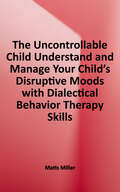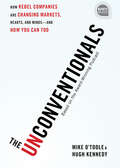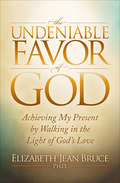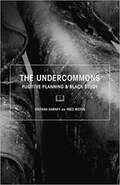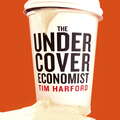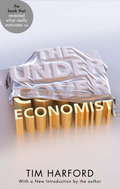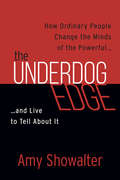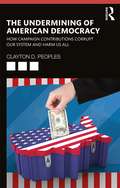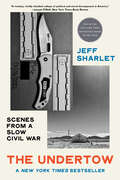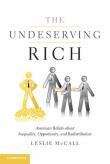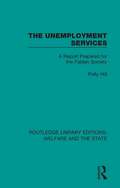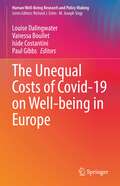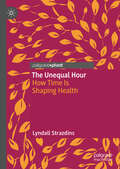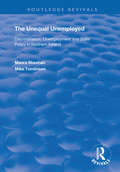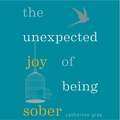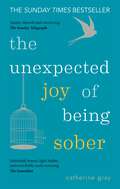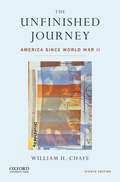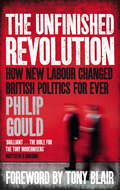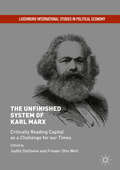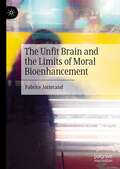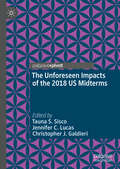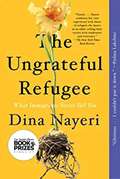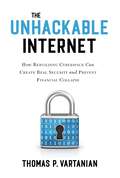- Table View
- List View
The Uncontrollable Child: Understand and Manage Your Child's Disruptive Moods With Dialectical Behavior Therapy Skills
by Matis MillerEvidence-based skills, insight, and methods drawn from dialectical behavior therapy (DBT) to help you gain a greater understanding of your child's behavior, parent them with compassion and confidence, and restore peace to your home. Is your child extremely irritable most of the time? Do they have difficulty interpreting social cues? Are they impulsive and prone to outbursts or explosive rages? <p><p>Parenting a child who has emotional dysregulation can be a bumpy ride. You've probably received advice—some of it unsolicited—from friends, teachers, and family members. But strategies and techniques that work for other kids are usually ineffective when it comes to your unique child, and can even lead to more stress for everyone in your family. <p><p>The Uncontrollable Child is here to help. Written for parents of children with emotion dysregulation disorders, including disruptive mood dysregulation disorder (DMDD), The Uncontrollable Child is a lifeline. It contains a powerful set of skills based in dialectical behavior therapy (DBT)--including mindfulness, validation, limit-setting, and behavior-shaping—to help you better understand your child and their behavior, and successfully find balance between acceptance and change, flexibility and consistency, and limits and love. As a parent, you want the very best for your child, but if you have a child with explosive emotions, you need extra help. Let this book guide you toward creating a nurturing, healthy, and loving environment in which your whole family can thrive.
The Unconventionals: How Rebel Companies Are Changing Markets, Hearts, and Minds-and How You Can Too (Ignite Reads #0)
by Hugh Kennedy Mike O'TooleWhat do electric shavers, craft beer, and DNA tests all have in common? They were all revolutionized by the Unconventionals. We've had our expectations turned upside down by leading brands like Converse, General Electric, and Waze simply because they saw things differently. How did they do that? By simply questioning the prevailing wisdom which then created outsized results and lasting change. Based on the award-winning podcast, The Unconventionals chronicles the amazing stories behind these solid business successes and shows you how reinventing your company (or starting a new one) can be easier than you think! Through in-depth interviews with the business visionaries who turned the unexpected into the expected you will learn how to become unconventional, too!
The Undeniable Favor of God: Achieving My Present by Walking in the Light of God's Love
by Elizabeth Jean BruceA licensed psychologist and trauma expert shares the story of how she met life&’s challenges and achieved personal fulfillment through faith. Having a sense of purpose significantly contributes to the quality of our lives. Many people experience God-given &“callings&” to achieve distinctive goals in life. These yearnings give us a sense of fulfillment by showing how we fit into the wholeness of creation. But discovering our purpose and establishing a major long-term goal are only the first steps of the journey. We must also understand what is required of us to reach our final destination, and make sure to note the milestones we achieve along the way. There will be difficult periods during the journey. To see our way through them, it helps to surround ourselves with people who strengthen our emotional, physical, and spiritual well-being. We must also utilize our faith in God, who keeps us fortified to endure disheartening times. Dr. Bruce believes that wonderful things happen as life unfolds. In The Undeniable Favor of God, she teaches others how to focus on the beauty, truth, and light of life.
The Undercommons: Fugitive Planning and Black Study
by Stefano Harney Fred MotenIn this series of essays, Fred Moten and Stefano Harney draw on the theory and practice of the black radical tradition as it supports, inspires, and extends contemporary social and political thought and aesthetic critique. <p><p> Today the general wealth of social life finds itself confronted by mutations in the mechanisms of control: the proliferation of capitalist logistics, governance by credit, and the management of pedagogy. Working from and within the social poesis of life in THE UNDERCOMMONS, Moten and Harney develop and expand an array of concepts: study, debt, surround, planning, and the shipped. <p><p> On the fugitive path of an historical and global blackness, the essays in this volume unsettle and invite the reader to the self-organised ensembles of social life that are launched every day and every night amid the general antagonism of THE UNDERCOMMONS.
The Undercover Economist
by Tim HarfordWho makes most money from the demand for cappuccinos early in the morning at Waterloo Station? Why is it impossible to get a foot on the property ladder? How does the Mafia make money from laundries when street gangs pushing drugs don't? Who really benefits from immigration? How can China, in just fifty years, go from the world's worst famine to one of the greatest economic revolutions of all time, lifting a million people out of poverty a month?Looking at familiar situations in unfamiliar ways, THE UNDERCOVER ECONOMIST is a fresh explanation of the fundamental principles of the modern economy, illuminated by examples from the streets of London to the booming skyscrapers of Shanghai to the sleepy canals of Bruges. Leaving behind textbook jargon and equations, Tim Harford will reveal the games of signals and negotiations, contests of strength and battles of wit that drive not only the economy at large but the everyday choices we make.
The Undercover Economist: Exposing Why The Rich Are Rich, Why The Poor Are Poor--and Why You Can Never Buy A Decent Used Car!
by Tim HarfordWho makes most money from the demand for cappuccinos early in the morning at Waterloo Station? Why is it impossible to get a foot on the property ladder? How does the Mafia make money from laundries when street gangs pushing drugs don't? Who really benefits from immigration? How can China, in just fifty years, go from the world's worst famine to one of the greatest economic revolutions of all time, lifting a million people out of poverty a month?Looking at familiar situations in unfamiliar ways, THE UNDERCOVER ECONOMIST is a fresh explanation of the fundamental principles of the modern economy, illuminated by examples from the streets of London to the booming skyscrapers of Shanghai to the sleepy canals of Bruges. Leaving behind textbook jargon and equations, Tim Harford will reveal the games of signals and negotiations, contests of strength and battles of wit that drive not only the economy at large but the everyday choices we make.
The Underdog Edge: How Ordinary People Change the Minds of the Powerful . . . and Live to Tell About It
by Amy ShowalterA prominent consultant reveals secrets to help you influence and persuade others—even when you aren&’t in a position of power. We all have occasions in which we want or need to persuade someone of greater clout, prestige, or authority to see things our way. There are books that show how to effect change from a leadership position or how to work with peers within your own organization—but what can you do when you need to exert &“upward influence&” with decision makers who can help you achieve your goals? In this book, a popular speaker and successful consultant with expertise in grassroots efforts shows which tactics are most successful when you&’re the underdog. She also shares real-world stories of everyday people who have achieved persuasion success in politics and business with someone up the food chain, the peer-reviewed science behind their success—as well as insights from those whose minds they changed.
The Undermining of American Democracy: How Campaign Contributions Corrupt our System and Harm Us All
by Clayton D. PeoplesThe public believes that politicians in the US favor special interests over their constituents and that our political institutions have become corrupt—and they are right. A growing body of evidence shows that special interests have disproportionate sway over policy via campaign contributions and lobbying. In this book, the author presents this evidence in a logical, understandable way; he then illustrates how campaign contributions harm our economy, exacerbate inequality, and undermine our democracy. One of the most startling findings of the book is that campaign contributions led to the Financial Crisis and Great Recession. The author concludes that campaign contributions have effectively created an oligarchy in the US, and, thus, reform is needed to save our democracy. The final chapter of the book suggests a number of different reforms that could be pursued—and highlights some ways in which these reforms can be achieved.
The Undertow: Scenes From A Slow Civil War
by Jeff SharletAn Instant New York Times Bestseller. A National Book Critics Circle Finalist for Nonfiction One of the New York Times 100 Notable Books of 2023 One of The New Republic's Best Books of 2023 “A riveting, vividly detailed collage of political and moral derangement in America.” —Joseph O’Neill, New York Times Book Review One of America’s finest reporters and essayists explores the powerful currents beneath the roiled waters of a nation coming apart. An unmatched guide to the religious dimensions of American politics, Jeff Sharlet journeys into corners of our national psyche where others fear to tread. The Undertow is both inquiry and meditation, an attempt to understand how, over the last decade, reaction has morphed into delusion, social division into distrust, distrust into paranoia, and hatred into fantasies—sometimes realities—of violence. Across the country, men “of God” glorify materialism, a gluttony of the soul, while citing Scripture and preparing for civil war—a firestorm they long for as an absolution and exaltation. Lies, greed, and glorification of war boom through microphones at hipster megachurches that once upon a time might have preached peace and understanding. Political rallies are as aflame with need and giddy expectation as religious revivals. At a conference for incels, lonely single men come together to rage against women. On the Far Right, everything is heightened—love into adulation, fear into vengeance, anger into white-hot rage. Here, in the undertow, our forty-fifth president, a vessel of conspiratorial fears and fantasies, continues to rise to sainthood, and the insurrectionist Ashli Babbitt, killed on January 6 at the Capitol, is beatified as a martyr of white womanhood. Framing this dangerous vision, Sharlet remembers and celebrates the courage of those who sing a different song of community, and of an America long dreamt of and yet to be fully born, dedicated to justice and freedom for all. Exploring a geography of grief and uncertainty in the midst of plague and rising fascism, The Undertow is a necessary reckoning with our precarious present that brings to light a decade of American failures as well as a vision for American possibility.
The Undeserving Rich: American Beliefs about Inequality, Opportunity, and Redistribution
by Leslie MccallIt is widely assumed that Americans care little about income inequality, believe opportunities abound, admire the rich, and dislike redistributive policies. Leslie McCall contends that such assumptions are based on both incomplete survey data and economic conditions of the past and not present. In fact, Americans have desired less inequality for decades, and McCall's book explains why. Americans become most concerned about inequality in times of inequitable growth, when they view the rich as prospering while opportunities for good jobs, fair pay and high quality education are restricted for everyone else. As a result, they favor policies to expand opportunity and redistribute earnings in the workplace, reducing inequality in the market rather than redistributing income after the fact with tax and spending policies. This book resolves the paradox of how Americans can express little enthusiasm for welfare state policies and still yearn for a more equitable society, and forwards a new model of preferences about income inequality rooted in labor market opportunities rather than welfare state policies.
The Unemployment Services: A Report Prepared for the Fabian Society (Routledge Library Editions: Welfare and the State #7)
by Polly HillOriginally published in 1940, The Unemployment Services provides a thorough examination of the system of unemployment relief. The book looks at fundamental proposals for the extension of necessary provisions for improving the conditions of the unemployed, and their dependents. The book provides a detailed knowledge of regulations and scales, and uses an unorthodox dissection of the principles embodied in this code of laws, which plays so large a part in the lives of industrial workers and their dependents.
The Unequal Costs of Covid-19 on Well-being in Europe (Human Well-Being Research and Policy Making)
by Paul Gibbs Louise Dalingwater Vanessa Boullet Iside CostantiniThis volume focuses on the wider wellbeing costs within European countries as a result of the outbreak of the pandemic and the control measures implemented thereafter. In particular, it considers to what extent Covid-19 and measures taken to cope with the crisis have weakened economic and social structures across Europe and what effect this has had on people’s lives. While many countries in Europe have reallocated public funding to health care, provided support to SMEs, vulnerable populations and regions hit by the crisis, the wellbeing or welfare costs, considered broadly, are still significant. The authors' assessment thus goes beyond the subjective wellbeing discourse and evaluates to what extent structural weaknesses within economic, social and regional frameworks have deepened. The chapters discuss what policies are needed to address these weaknesses. the volume thus recognises that structural inequalities are a key driver of wellbeing. While there have been a number of publications on wellbeing during the pandemic, the original perspective in each chapter on inequalities and the European focus of this publication provide novel information and insights on the topic.
The Unequal Hour: How Time Is Shaping Health
by Lyndall StrazdinsThis book is about the urgent need to have time for health. It's about why people don’t exercise, rest or eat healthy food even when they know they need to. Time has become the prescription needed to halt chronic diseases, 30 minutes of physical activity every day is a minimum, but this book argues against telling people to do more. It explains why it’s not laziness, ignorance or lack of motivation that’s the problem for unhealthy lifestyles, and why so many people lack time for their health. The book connects ideas from economics, sociology, political economy and public health to work-family dilemmas, gender and social inequality. It ends by canvassing interventions and actions from the personal, to the workplace, health promotion and urban design.
The Unequal Unemployed: Discrimination, Unemployment and State Policy in Northern Ireland (Routledge Revivals)
by Mike Tomlinson Maura SheehanFirst published in 1999, this volume is about unemployment and discrimination, with a focus on Northern Ireland and its debate over patterns of inequality between unemployed Catholics and Protestants. The Unequal Unemployed uses the important and revealing context of Northern Ireland to review the international debate on discrimination and the role of unemployment within it. This intellectual and political debate, active throughout the past decade, represents a conflict between: a) The traditional view that unequal unemployment is evidence of labour market discrimination against minorities and other distinct social groupings. b) Recent models which explain unemployment either in terms of individual responsibility or innate inferiority and attack the 'equal opportunities industry for its attempts at social engineering. Maura Sheehan and Mike Tomlinson approach these theories using unique survey evidence, gathered through a comprehensive evaluation of anti-discrimination policy. They contradict the view that differences in unemployment between Catholics and Protestants in Northern Ireland are the result of personal attitudes and 'religious culture'. The book demonstrates that unequal unemployment arises from various discriminatory structures and practices - all of which are amenable to policy intervention. However, while more radical measures may achieve change, these must be developed within a policy framework which stimulates labour demand and economic development. Such a framework is constrained by the continuing political conflict within Northern Ireland.
The Unexpected Joy of Being Sober: THE SUNDAY TIMES BESTSELLER
by Catherine GrayTHE SUNDAY TIMES BESTSELLER 'Gray's tale of going sober is uplifting and inspiring' - The Evening Standard 'An icon of the Quit Lit movement' - Condé Nast Traveller 'Fascinating' - Bryony Gordon 'Not remotely preachy' - The Times 'Jaunty, shrewd and convincing' - Sunday Telegraph 'Admirably honest, light, bubbly and remarkably rarely annoying' - Alice O'Keeffe, Guardian 'Truthful, modern and real' - Stylist 'Brave, witty and brilliantly written' - Marie Claire 'The Unexpected Joy of Being Sober came to me at a time when I much needed it... The book became my best friend, and got me through, and took me on a journey.' - Sadie Frost 'Particularly lovely, because it's not a deep and dark dive into someone's terrible addiction. It's a celebration of everything that she has gained from not drinking' - Laura Donnelly Ever sworn off alcohol for a month and found yourself drinking by the 7th? Think there's 'no point' in just one drink? Welcome! There are millions of us. 64% of Brits want to drink less.Catherine Gray was stuck in a hellish whirligig of Drink, Make horrible decisions, Hangover, Repeat. She had her fair share of 'drunk tank' jail cells and topless-in-a-hot-tub misadventures.But this book goes beyond the binges and blackouts to deep-dive into uncharted territory: What happens after you quit drinking? This gripping, heart-breaking and witty book takes us down the rabbit-hole of an alternative reality. A life with zero hangovers, through sober weddings, sex, Christmases and breakups.In The Unexpected Joy of Being Sober, Catherine Gray shines a light on society's drink-pushing and talks to top neuroscientists and psychologists about why we drink, delving into the science behind what it does to our brains and bodies.Much more than a tale from the netherworld of addicted drinking, this book is about the escape, and why a sober life can be more intoxicating than you ever imagined. Whether you're a hopelessly devoted drinker, merely sober-curious, or you've already ditched the drink, you will love this book. 'Haunting, admirable and enlightening' - The Pool 'A riveting, raw, yet humorous memoir with actionable advice. A truly unique blend of storytelling and science that holds a universe of hope.' - Annie Grace, author of This Naked Mind 'Like listening to your best friend teach you to be sober. Lighthearted but serious, it's packed with ideas, tools, tips and, most importantly, reasons for living a sober life. This book is excellent.'- Eric Zimmer, host of podcast The One You Feed 'Gray's fizzy writing succeeds in making this potentially boring-as-hell subject both engaging and highly seductive' - The Bookseller 'Catherine Gray is an exceptional writer. Her exquisitely crafted thoughts on the joys of being sober are not only deeply honest and pragmatic, but she manages to infuse tons of humor. This is a delightful, informative, and compelling read for all those who are sober or seeking sobriety.' - Sasha Tozzi, Huffington Post columnist 'Catherine's writing style and voice captivate me. She has a way of translating her story into an experience I don't want to end. I want to drink every drop she produces.' - Holly Whitaker, founder of Hip Sobriety School and co-presenter of Home podcast 'This book is great. A balanced, informative and entertaining mélange of memoir, sociology and psychology. I identified very strongly with huge sections of it.' - Jon Stewart, guitari
The Unexpected Joy of Being Sober: THE SUNDAY TIMES BESTSELLER (The Unexpected Joy Of #1)
by Catherine GrayGoing sober will make you happier, healthier, wealthier, slimmer and sexier. Despite all of these upsides, it's easier said than done. This inspirational, aspirational and highly relatable narrative champions the benefits of sobriety; combining the author's personal experience, factual reportage, contributions from experts and self-help advice.
The Unexpected Joy of Being Sober: THE SUNDAY TIMES BESTSELLER (The Unexpected Joy Of #1)
by Catherine GrayGoing sober will make you happier, healthier, wealthier, slimmer and sexier. Despite all of these upsides, it's easier said than done. This inspirational, aspirational and highly relatable narrative champions the benefits of sobriety; combining the author's personal experience, factual reportage, contributions from experts and self-help advice.
The Unfinished Journey: America Since World War II
by William H. ChafeBrilliantly written by a prize-winning historian, The Unfinished Journey, Eighth Edition, considers both the paradoxes and the possibilities of postwar America. William H. Chafe portrays the significant cultural and political themes that have colored our country's past and present, including issues of race, class, gender, foreign policy, and economic and social reform. He examines such subjects as the Vietnam War, the civil rights movement, the origins and the end of the Cold War, the culture of the 1970s, the rise of the New Right, the events of September 11th and their aftermath, and various presidencies.
The Unfinished Revolution: How New Labour Changed British Politics Forever
by Philip GouldThe Unfinished Revolution is the definitive story of New Labour from its genesis to its election defeat 2010 - covering over 25 years and six general elections of strategy, rebuilding and reinvention. In this extraordinary book, Philip Gould, one of the world's leading political strategists and a key adviser to Tony Blair during the period, brilliantly describes how New Labour came to dominate, falter and fall, assessing how successful it was in government, and where it should go from here. Drawing on his years of experience at the heart of New Labour he gives us his unique perspective on how best to understand the electorate, how to communicate policy and how to adapt in a rapidly changing world.
The Unfinished Revolution: How New Labour Changed British Politics Forever
by Philip GouldThe Unfinished Revolution is the definitive story of New Labour from its genesis to its election defeat 2010 - covering over 25 years and six general elections of strategy, rebuilding and reinvention. In this extraordinary book, Philip Gould, one of the world's leading political strategists and a key adviser to Tony Blair during the period, brilliantly describes how New Labour came to dominate, falter and fall, assessing how successful it was in government, and where it should go from here. Drawing on his years of experience at the heart of New Labour he gives us his unique perspective on how best to understand the electorate, how to communicate policy and how to adapt in a rapidly changing world.
The Unfinished System of Karl Marx: Critically Reading Capital As A Challenge For Our Times (Luxemburg International Studies In Political Economy Ser.)
by Judith Dellheim Frieder Otto WolfThis book examines what we can gain from a critical reading of Marx's final manuscript and his conclusion of the "systematic presentation" of his critique, which was the basis for Engels's construction of the third volume of his infamous 'Capital'. The text introduces the reader to a key problem´of Marx's largely implicit epistemology, by exploring the systematic character of his exposition and the difference of this kind of 'systematicity' from Hegelian philosophical system construction. The volume contributes to establishing a new understanding of the critique of political economy, as it has been articulated in various debates since the 1960s - especially in France, Germany, and Italy - and as it had already been initiated by Marx and some of his followers, with Rosa Luxemburg in a key role. All the chapters are transdisciplinary in nature, and explore the modern day relevance of Marx's and Luxemburg's theoretical analysis of the dominance of the capitalist mode of production.
The Unfit Brain and the Limits of Moral Bioenhancement
by Fabrice JotterandIn light of the potential novel applications of neurotechnologies in psychiatry and the current debate on moral bioenhancement, this book outlines the reasons why more conceptual work is needed to inform the scientific and medical community, and society at large, about the implications of moral bioenhancement before a possible, highly hypothetical at this point, broad acceptance, and potential implementation in areas such as psychiatry (e.g., treatment of psychopathy), or as a measure to prevent crime in society. The author does not negate the possibility of altering or manipulating moral behavior through technological means. Rather he argues that the scope of interventions is limited because the various options available to “enhance morality” improve, or simply manipulate, some elements of moral behavior and not the moral agent per se in the various elements constitutive of moral agency. The concept of Identity Integrity is suggested as a potential framework for a responsible use of neurotechnologies in psychiatry to avoid human beings becoming orderers and orderables of technological manipulations.
The Unforeseen Impacts of the 2018 US Midterms
by Christopher J. Galdieri Jennifer C. Lucas Tauna S. SiscoThis book explores multiple stories of the 2018 US midterm elections. From retirements and redistricting, to #MeToo and tariffs, it synthesizes the consequences through a thoughtful, empirical analysis. As the final votes are counted, we scholars know that midterm elections matter and have unforeseen consequences for decades to come.
The Ungrateful Refugee: What Immigrants Never Tell You
by Dina NayeriAged eight, Dina Nayeri fled Iran along with her mother and brother and lived in the crumbling shell of an Italian hotel–turned–refugee camp. Eventually she was granted asylum in America. She settled in Oklahoma, then made her way to Princeton University. In this book, Nayeri weaves together her own vivid story with the stories of other refugees and asylum seekers in recent years, bringing us inside their daily lives and taking us through the different stages of their journeys, from escape to asylum to resettlement. In these pages, a couple fall in love over the phone, and women gather to prepare the noodles that remind them of home. A closeted queer man tries to make his case truthfully as he seeks asylum, and a translator attempts to help new arrivals present their stories to officials. Nayeri confronts notions like “the swarm,” and, on the other hand, “good” immigrants. She calls attention to the harmful way in which Western governments privilege certain dangers over others. With surprising and provocative questions, The Ungrateful Refugee challenges us to rethink how we talk about the refugee crisis.
The Unhackable Internet: How Rebuilding Cyberspace Can Create Real Security and Prevent Financial Collapse
by Thomas P. VartanianLike most aspects of modern existence, more and more of our financial lives have migrated to the digital realm. With the benefits of ease that our Internet allows us, that transition also raises numerous – and dangerous – threats to national security, our money, and the systems we use to store and transfer it. In TheUnhackable Internet, financial services and technology expert Thomas P. Vartanian exposes the vulnerabilities of the many networks that we rely on today as well as the threats facing the integrity of our national security and financial services sector. From cyberattacks by foreign adversaries like China and Russia, the explosion of cryptocurrency, the advancement of ransomware, phishing, surveillance apps, spying software, and logic bombs, along with the increasing savvy and daring shown by Internet hackers, the next financial panic is likely to be delivered to us through use or abuse of technology. The Unhackable Internet describes how society can remake an Internet that was never conceived as a secure environment and badly tainted by the original sin of substandard coding. Vartanian argues for increasing the use of private and offline network infrastructures, controlling the ownership of Internet infrastructure, and imposing enhanced authentication, governance, and enforcement standards. This online universe would look more like our analog lives, authenticating all digital traffic to a real person and removing any virtual traveler that violated the new rules of the road. The Unhackable Internet poses a challenge to America: take the lead and create a coalition of democratic nations to implement financial cyber strategies or be left with no counterweight short of military power to respond to those who weaponize technology. This comprehensive and compelling book makes it clear that nothing less than the control of global economies is up for grabs, and that how we use technology is our choice.
